
Underwater footage of a mother blue whale nursing its calf has been caught on camera for the first time, providing a rare glimpse into the private life of Earth’s largest animal.
The video was recently filmed off the coast of Timor-Leste in Southeast Asia by a research and citizen science program led by the Australian National University (ANU) that has been studying blue whales in these waters since 2006.
It shows a young calf suckling milk from its mother as the pair embark on their annual 5,000-kilometer (3,100-mile) migration between southern Australia and the Banda Sea near eastern Indonesia.
This part of the sea is known as a cetacean hotspot that regularly sees the passage of blue whales, beaked whales, short-finned pilot whales, melon-headed whales, and six dolphin species. It also has its fair share of sharks and turtles. The region’s deep ocean channels, which plunge to depths of over 3,000 meters (9,800 feet), serve as a major migratory highway for marine wildlife traveling between the Pacific Ocean and the Indian Ocean.
“Timor-Leste’s deep, nearshore waters, particularly in the narrow Ombai-Wetar Strait along the north coast of the country, provide one of the most accessible and best locations for blue whale research in the world,” Associate Professor Karen Edyvane at ANU, who is also an Adjunct Senior Research Fellow at Charles Darwin University, said in a statement.
“From newborn calves and nursing mothers to amorous adults in courtship, the waters of Timor-Leste really are providing blue whale scientists with some of our first glimpses into the private lives of one of the world’s largest but most elusive animals,” she added.
The appearance of a blue whale calf near Timor-Leste is especially poignant as it shows the region plays a role in the reproduction and early life of these magnificent creatures.
“This evidence suggests that these waters are not only important foraging areas for blue whales, but also are critical for reproduction. Until now, it has been a mystery when, where and how blue whales reproduce,” added Dr Elanor Bell, a researcher at the Australian Antarctic Division.
Blue whales can grow up to 33 meters (108 feet) in length, making them the largest animal to ever exist on planet Earth. Despite what you might have heard, it’s also the heaviest animal to ever live, weighing 270 metric tons.
It’s estimated that over 350,000 blue whales lived in the ocean centuries ago, but prolific whaling in the 19th and early 20th centuries decimated their population numbers. Today, no more than 25,000 individuals are alive.
Although still considered an endangered species, there’s evidence to suggest blue whales are making a strong recovery and their global population is increasing.
Source Link: First-Ever Footage Of Blue Whale Mother Nursing Its Calf On A 5,000-Kilometer Journey